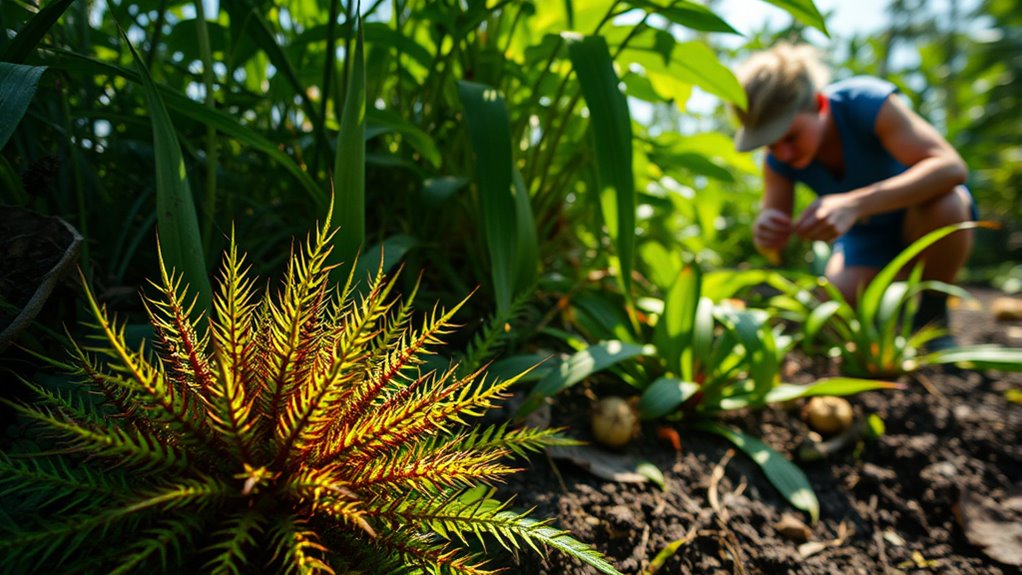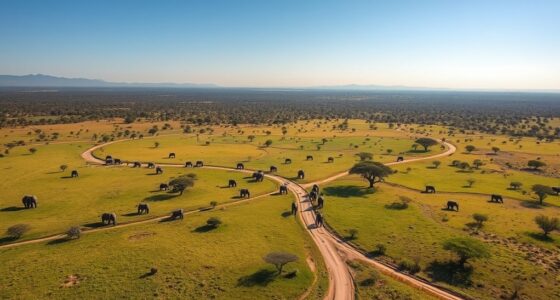Invasive species threaten ecosystems by outcompeting native organisms, leading to biodiversity loss and habitat destruction. They often spread through human activities and adapt easily to new environments. These invaders cost the U.S. billions annually in lost crops and management efforts. To combat this, you can participate in community clean-ups, report sightings, and support regulations against harmful species. There are also innovative strategies involving technology to help manage these threats more effectively. Discover more ways to get involved!
Key Takeaways
- Invasive species disrupt ecosystems, threaten biodiversity, and lead to economic losses exceeding $21 billion annually in the U.S. alone.
- Human activities and climate change facilitate the spread of invasive species across regions, impacting local wildlife and habitats.
- Prevention strategies include education, early detection, and regulatory measures to restrict harmful species importation.
- Community engagement through clean-up events and volunteer reporting enhances awareness and management of invasive species.
- Technology, such as smartphone apps, aids in mapping and reporting invasive species, streamlining community participation in management efforts.
Understanding Invasive Species
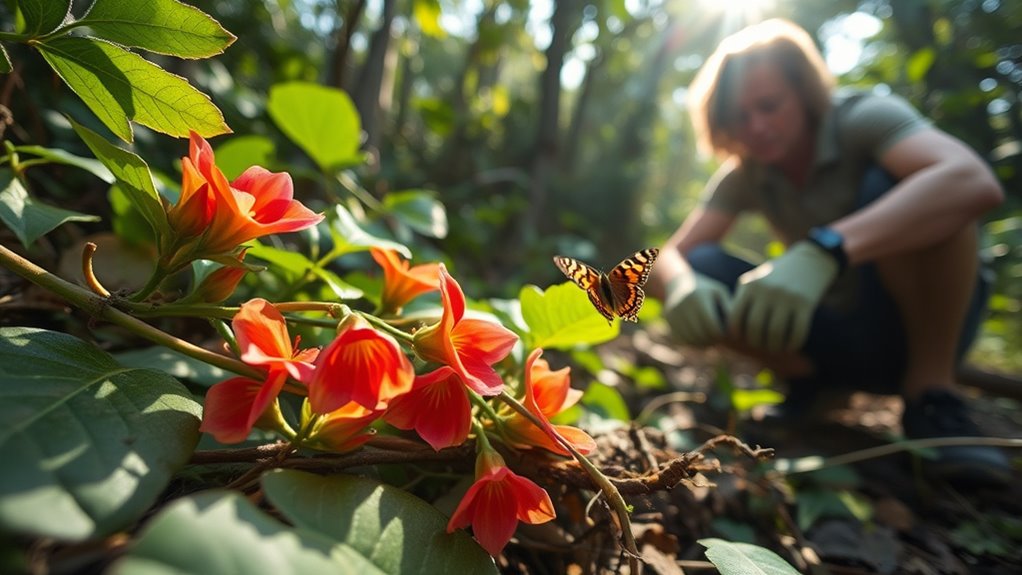
While many people enjoy the beauty of diverse ecosystems, invasive species threaten this balance by introducing non-native organisms that can wreak havoc.
These organisms—whether plants, animals, fungi, or microorganisms—can disrupt habitats and cause significant ecological and economic damage. Invasive species tend to grow and reproduce rapidly, often exploiting resources that native species can’t access. Invasive species can kill important trees, affecting shade, carbon storage, and wildlife habitat. Additionally, their unchecked growth can lead to deforestation and climate change, further exacerbating the stress on native ecosystems. Healthy ecosystems provide essential services such as clean air and water, which are further threatened by invasive species. The introduction of renewable energy solutions can help restore degraded habitats by promoting biodiversity and supporting native species recovery.
Lacking natural predators in their new environments, they can outcompete native species for vital resources. This competition leads to biodiversity loss, habitat destruction, and even the extinction of local species.
Examples like kudzu vine and European rabbits illustrate the wide-ranging impacts invasive species can have. Understanding these threats is crucial for preserving the delicate balance of our ecosystems.
Causes of Invasive Species Spread
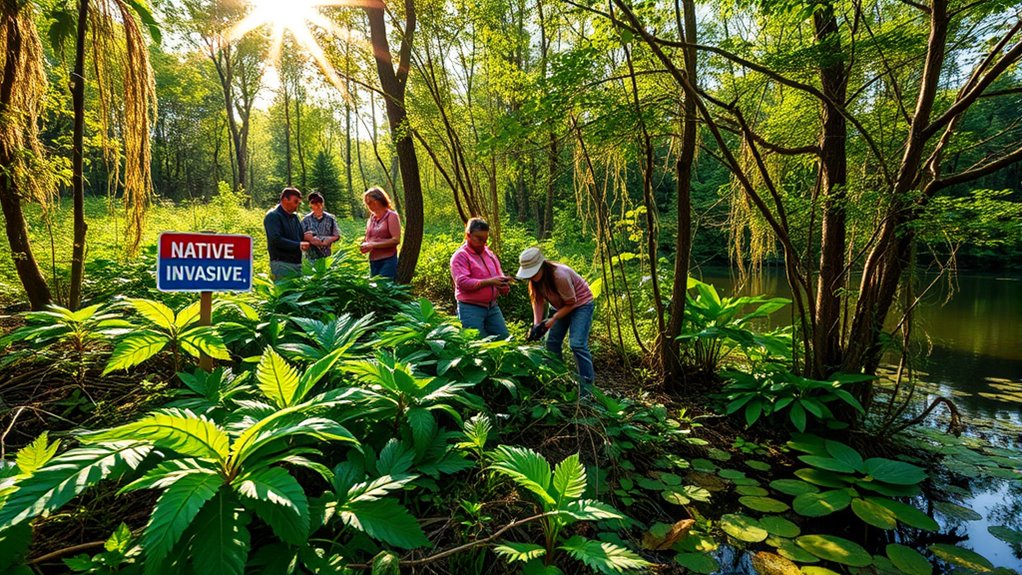
Invasive species spread primarily due to human activities and environmental factors that create opportunities for these organisms to thrive.
When you travel, trade, or engage in tourism, you inadvertently contribute to their movement. Globalization accelerates this process, allowing species to hitch rides across the globe. Climate change plays a role too, enabling these organisms to adapt to new environments. Additionally, an estimated 50,000 non-native species have been introduced to the USA due to human actions, further exacerbating the issue. The required minimum distributions of resources can also lead to the overconsumption of native species, making it easier for invasive species to thrive. Eco-friendly travel practices can help mitigate these impacts by promoting awareness and responsible tourism. Emerging technologies, such as smart tracking systems, can also aid in monitoring and managing invasive species.
Many species are introduced accidentally, like through ballast water or transported goods, while others are planted intentionally for agriculture or recreation. Frequent introductions and larger numbers increase their chances of establishing themselves.
Disturbed ecosystems, aggressive root systems, and the absence of natural predators further facilitate their spread, helping them outcompete native species for resources.
Economic Impact of Invasive Species
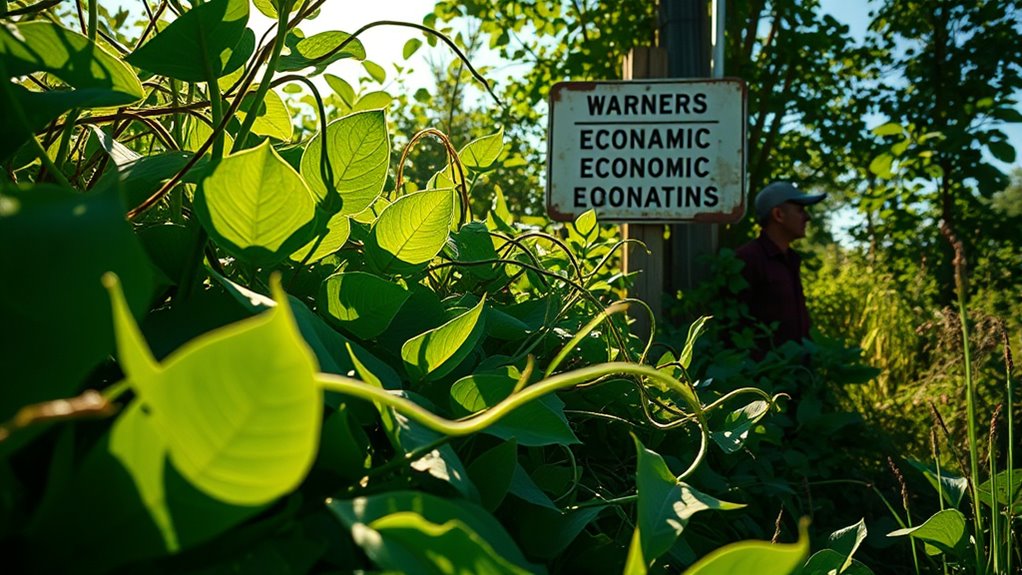
The economic impact of invasive species is staggering, costing the United States over $21 billion annually and the global economy at least $423 billion each year.
The agricultural sector bears the brunt of this burden, facing significant crop yield reductions and management costs. Most of the expenses arise from resource damages and losses, accounting for 73% of the total costs in the U.S. Invasive species cost farmers hundreds of millions of dollars due to damages and management practices. Furthermore, mammography guidelines recommend early detection strategies that can also be applied to monitor invasive species’ spread, helping to stabilize agricultural outputs. Additionally, similar to how gold investments can provide a hedge against economic instability, managing invasive species can help stabilize agricultural outputs. Louisiana alimony laws underscore the importance of financial planning, which is essential for farmers facing the economic challenges posed by invasive species.
Invasive species not only threaten jobs in industries like forestry but also damage infrastructure and decrease property values.
Moreover, the indirect effects, such as loss of ecosystem services and impacts on tourism, further strain local economies. Proactive prevention measures and effective management strategies are essential to mitigate these economic challenges.
Ecological Consequences of Invasive Species
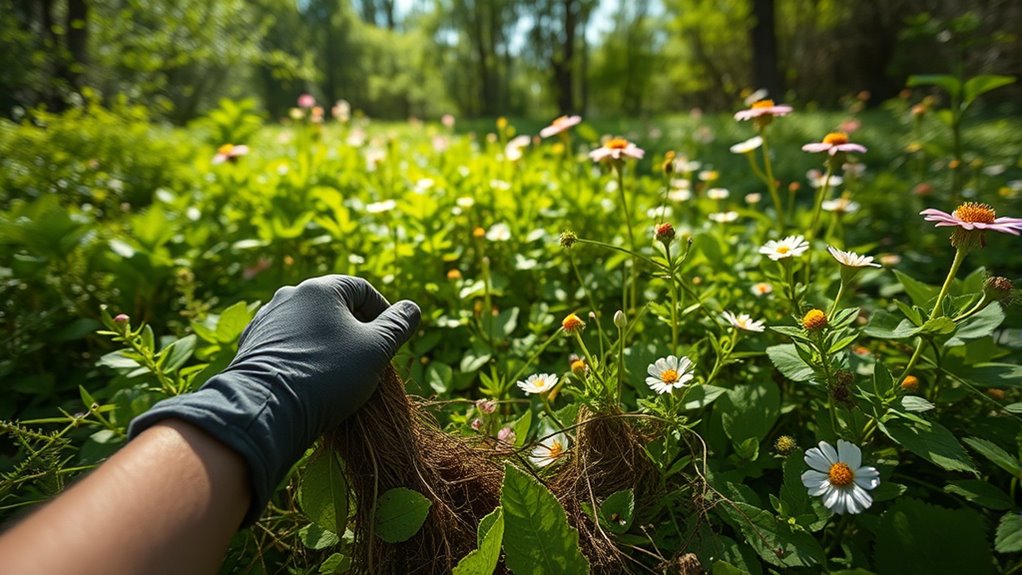
When invasive species enter an ecosystem, they can trigger a cascade of ecological consequences that threaten native biodiversity and disrupt essential processes.
You may notice that these invaders outcompete native species for vital resources like food and habitat, leading to a decline in native populations. This competition can result in the extinction risk for about 42% of endangered species.
Invasive species often alter habitats, simplify ecosystems, and change nutrient cycling, which can affect soil chemistry and water quality. Additionally, their rapid reproduction and aggressive spreading can lead to significant population declines in native species. This can further exacerbate the issue by creating a scenario where proper maintenance of native species becomes increasingly difficult. Moreover, the emotional toll of invasive species on ecosystems can be likened to the emotional volatility seen in relationships affected by BPD, complicating the restoration process. Creative practice can also play a vital role in developing innovative strategies for managing invasive species effectively.
Furthermore, they disrupt food webs by replacing native food sources and altering predator-prey dynamics.
These changes can have long-lasting effects, making ecosystems less resilient to further disturbances and hindering their recovery for generations to come.
Prevention Strategies for Invasive Species

After recognizing the significant ecological consequences invasive species can inflict on native ecosystems, it’s vital to focus on prevention strategies that can mitigate their impact.
Start by educating yourself and others about the dangers of invasive species; awareness can significantly reduce their unintentional spread. Engaging in early detection and rapid response efforts to identify new infestations quickly is crucial, as regular assessments can help maintain ecosystem health. Supporting regulations that restrict the import and movement of potentially harmful species is important, and understanding color accuracy can inform choices that minimize the introduction of invasive species through landscaping.
When outdoors, always clean your gear and avoid moving soil or seeds between areas. Opt for native plants in your garden to diminish the risk of introducing invasives.
Community Efforts to Combat Invasive Species
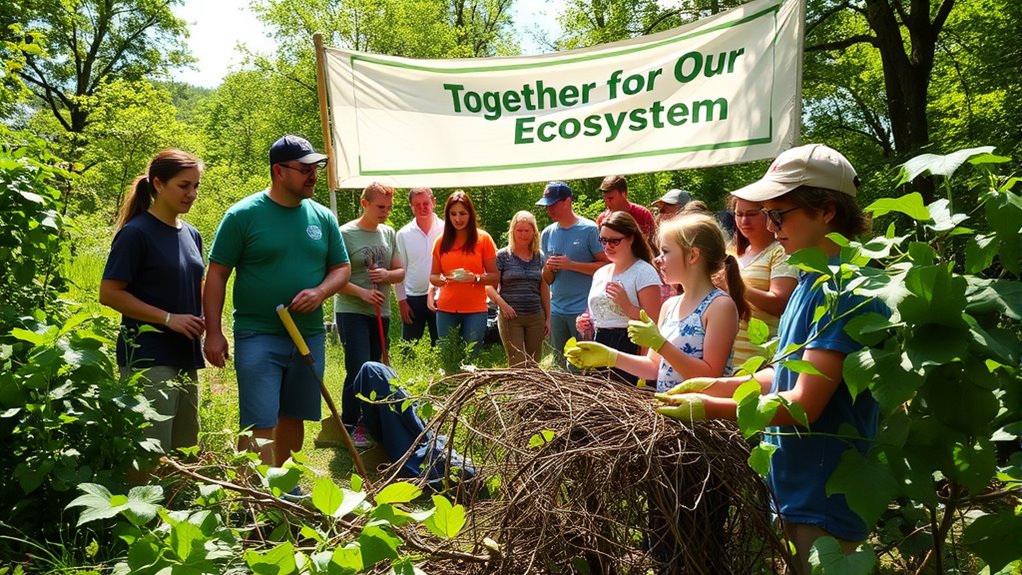
Engaging your community in the fight against invasive species not only protects local ecosystems but also fosters a sense of environmental stewardship among residents. Organizing events like clean-ups helps you and your neighbors work together to remove invasives and learn about their impacts. Volunteers play a crucial role in identifying and reporting sightings, enhancing community knowledge and engagement. Community involvement is essential for effective invasive species management, as it leads to increased public recognition of invasive species and can prevent their further spread. Collaborating with local organizations boosts effectiveness, while educational campaigns raise awareness and promote responsibility. Incorporating financial considerations for elderly care can also help in securing resources for community initiatives. Utilizing balanced nutrition can encourage volunteers to maintain their energy levels during these efforts. Furthermore, understanding the importance of emotional manipulation can help volunteers navigate challenges in collaboration and maintain a positive atmosphere. Technology, like smartphone apps, streamlines reporting and mapping, making it easier for everyone to participate. By joining forces with local businesses, you can also help inform consumers about invasive species. Together, your community can develop strategies to combat these threats and adapt to climate change.
Frequently Asked Questions
How Can I Identify Invasive Species in My Area?
To identify invasive species in your area, start by researching local guidelines and common invasive plants and animals.
Use mobile apps like GLEDN to report sightings, or participate in citizen science projects.
You can also conduct field surveys, utilizing high-resolution images to spot differences in native vs. invasive species.
If unsure, reach out to local extension services or conservation groups for assistance.
Early identification helps protect your environment from these harmful invaders.
Are All Non-Native Species Considered Invasive?
Not every non-native species is an invasive villain!
Sure, some arrive like uninvited guests, wreaking havoc on ecosystems, but others play nice, enhancing biodiversity.
You’ll find some non-natives are just like tourists—enjoying the scenery without causing chaos.
So, when you spot a non-native species, don’t jump to conclusions.
Check if it’s harming the local environment.
Understanding this distinction helps you appreciate nature’s complexity while protecting what truly matters.
What Are Some Success Stories in Controlling Invasive Species?
You’ll find inspiring success stories in controlling invasive species worldwide.
For instance, islands like Macquarie and Dirk Hartog have seen successful eradications of invasive predators.
In U.S. national parks, efforts to restore native plants have significantly boosted biodiversity.
Additionally, using natural enemies as biological controls has proven effective in managing infestations.
These achievements highlight how community involvement and strategic planning lead to healthier ecosystems, encouraging you to participate in similar initiatives.
How Do Invasive Species Affect Local Wildlife Behavior?
Invasive species significantly affect local wildlife behavior.
When you observe native animals, you might notice they change their foraging patterns or avoid certain areas due to invasive plants. These invaders can mislead animals, creating evolutionary traps that confuse their survival instincts.
As a result, you’ll see reduced reproduction rates and diminished survival chances among native species. Over time, these behavioral shifts can lead to permanent adaptations, impacting the entire ecosystem.
Can Invasive Species Ever Become Beneficial in an Ecosystem?
Did you know that around 15% of invasive species can actually enhance biodiversity?
Invasive species can sometimes benefit ecosystems by filling ecological gaps. For example, European green crabs help control native marsh crab populations, aiding salt marsh recovery.
Similarly, invasive honeybees play a vital role in pollination.
While invasive species often pose risks, they can also restore balance, providing food and habitat for native species and supporting overall ecosystem health.
Conclusion
By understanding the threat of invasive species and their far-reaching impacts, you can play a crucial role in combating this pressing issue. Remember, a single invasive plant can spread like wildfire, choking our native ecosystems and disrupting local economies. But together, through prevention strategies and community efforts, we can turn the tide. Your actions, no matter how small, can create a ripple effect and help protect our natural world for generations to come.
